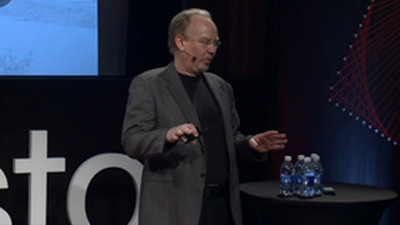(单词翻译:单击)
听力文本
I mean, architects have been thinking about these ideas for a long time. What we need to do now,develop things that can scale to those 300 million Chinese people that would like to live in the city,and very comfortably.
我想,建筑师很长时间一直在思考这个问题,我们现在需要去做的,是开发一些东西,使得3亿中国人能容纳进城市里,并且生活得安逸。
We think we can make a very small apartment that functions as if it's twice as big by utilizing these strategies. I don't believe in smart homes.
我觉得我们能造出一套公寓出来利用以上的那些策略,令房子的实际用途可以达到它两倍大小的作用。我不信智能家居。
That's sort of a bogus concept.
那是虚假的概念
I think you have to build dumb homes and put smart stuff in it.
我觉得应该建造愚笨家居然后放些智能的东西进去。

And so we've been working on a chassis of the wall itself.
我们现在已经在研发机器墙的底架。
You know, standardized platform with the motors and the battery when it operates, little solenoids that will lock it in place and get low-voltage power.
还有带着发动机和电池的标准平台,还有可以固定在一个地方收集低压电力的小螺丝管。
We think this can all be standardized, and then people can personalize the stuff that goes into that wall,and like the car, we can integrate all kinds of sensing to be aware of human activity, so if there's a baby or a puppy in the way, you won't have a problem.
我们觉得这可以标准化那样人们就可以个性化墙上的其他物品,就像那辆车一样,我们能完善各种感应人类活动的传感装置,所以哪怕有婴儿或小狗路中挡道,也不会出大乱子。
So the developers say, well this is great. Okay,so if we have a conventional building,we have a fixed envelope, maybe we can put in 14 units.
开发商说也觉得这样很不错,很赞同,所以如果我们有一栋传统的建筑,有一个固定的底线,那么我们可能可以放14个单位进去。
If they function as if they're twice as big,we can get 28 units in.
如果他们能用起来像两倍的空间一样,那么我们就等于放进28个单位了。
That means twice as much parking, though.
这就意味着有两倍的泊车空间。
Parking's really expensive. It's about 70,000 dollars per space to build a conventional parking spot inside a building.
泊车真的是很贵的,在一栋建筑物里建一个传统型的停车场,每个车位大约要7万美金。
So if you can have folding and autonomy,you can do that in one seventh of the space.
所以如果能折叠,也有自动化,那么你只需七分之一个停车位。
That goes down to 10,000 dollars per car,just for the cost of the parking.
每辆车就只需花1万美金而已,就单停车这一项。
You add shared use, and you can even go further.
如果加上共享使用,那么你行动范围就更大了。
We can also integrate all kinds of advanced technology through this process.
我们能在这一个过程中加入各种高科技创新型公司。
There's a path to market for innovative companies to bring technology into the home.
把科技融入家居中这方面的市场也是行得通的。
In this case, a project we're doing with Siemens,we have sensors on all the furniture, all the infill,that understands where people are and what they're doing.
有这么个项目,我们正和西门子在合作,我们在所有的家具和填充物中加入传感器,能感知人们的位置和所做的事情。
Blue light is very efficient, so we have these tunable 24-bit LED lighting fixtures.
蓝光是很有效率的,所以我们做出了可调节的24位LED灯固定装置。
It recognizes where the person is, what they're doing,fills out the light when necessary to full spectrum white light,and saves maybe 30, 40 percent in energy consumption,we think, over even conventional state-of-the-art lighting systems.
它能辨识人的位置,以及所做的事情,需要的时候就变为全光谱的白灯,并节省下30%到40%的能源消耗,我们觉得,这比传统的最新型照明系统还要节能。
This just shows you the data that comes from the sensors that are embedded in the furniture.
这里的数据是来自那些传感器的就安装在家具里面。
We don't really believe in cameras to do things in homes.
我们不认为摄像机能在家里帮得上忙。
We think these little wireless sensors are more effective.
我们觉得这些小型无线传感器更给力。
We think we can also personalize sunlight.
我们也可以将日光个性化。
That's sort of the ultimate personalization in some ways.
某种程度上,这算是一种终极的个性化了。
So we, we've looked at articulating mirrors of the facade that can throw shafts of sunlight anywhere into the space,therefore allowing you to shade most of the glass on a hot day like today.
我们现在看到的就是连接镜的正面它能往空中投射光束,这样就能在像今天一样热的天气里遮蔽掉大部分的光线。
In this case, she picks up her phone, she can map food preparation at the kitchen island to a particular location of sunlight.
在这个例子中,她拿起手机,在准备食物时在岛式厨房上指定位置映射出阳光。
An algorithm will keep it in that location as long as she's engaged in that activity.
会有一个算法能记住这个映射位置,只要她还在这个活动的过程中,
This can be combined with LED lighting as well.
这也能和LED照明结合起来。
We think workplaces should be shared.
我们认为工作场所也应该共享。
I mean, this is really the workplace of the future, I think.
我意思是,我觉得这真的就是未来的工作场所。
This is Starbucks, you know.
其实,这是星巴克。
Maybe a third —And you see everybody has their back to the wall and they have food and coffee down the way and they're in their own little personal bubble.
或许三分之—你可以看到每个人都背靠着墙,桌上有食物和咖啡,他们都融入到自己的小私人空间里。
We need shared spaces for interaction and collaboration.
我们需要共享的空间进行互动和合作。
We're not doing a very good job with that.
这方面,我们做得不是很好。
At the Cambridge Innovation Center, you can have shared desks. I've spent a lot of time in Finland at the design factory of Aalto University,where the they have a shared shop and shared Fablab,shared quiet spaces,electronics spaces,recreation places.
在剑桥创新中心有能共享的桌子。我曾在芬兰阿尔托大学的设计工厂待过很长时间,那儿有共享的商店和私人实验室,共享安静的环境,电子设备环境,休闲场地。
We think ultimately all of this stuff can come together,
我们相信这些最终都会结合在一起,
a new model for mobility, a new model for housing,a new model for how we live and work,a path to market for advanced technologies,but in the end the main thing we need to focus on are people. Cities are all about people.
成为新型的流动方式,新型的住宅方式,新型的生活工作方式,也为高科技市场打开门道,但最终我们需要关注的是人类。城市和人类是分不开的。
They're places for people.
他们是人类的住所。
There's no reason why we can't dramatically improve the livability and creativity of cities,like they've done in Melbourne with the laneways while at the same time dramatically reducing CO2 and energy.
所以没有理由不去大力提升城市的宜居性和创意性,就像在墨尔本的巷道一样同时也大规模地降低了CO2排放量和能源使用量。
It's a global imperative. We have to get this right.
这个全球性问题迫在眉睫,刻不容缓。
Thank you.
谢谢。
演讲视频
要怎样才能使更多的人住进城市中,而不显得过分拥挤呢?Kent Larson展示了折叠汽车,可快速调整的公寓,还有其他的创新作品,他们都能使得城市变得和以前的小村庄一样舒适。


